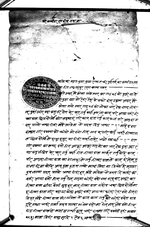A letter from Jīta Jaṅga appointing Chima Dorjye as jimmāvāla of 14 villages of Syāra (VS 1937)
ID: L_1200_0009C
Edited and
translated by Rajendra Shakya
in collaboration with
Yogesh Budathoki
Created: 2019-06-27;
Last modified: 2023-01-24
For the metadata of the document, click here
The accompanying edition, translation/synopsis and/or commentary are available under the terms of the Creative Commons Attribution-ShareAlike 4.0 International License
Abstract
This letter from Jīta Jaṅga appoints Chima Dorjye [Khunu] as jimmāvāla of 14 villages of Syāra after local residents had declined to accept Chāṃvā and Kaisāṃ Khunu in the post. The sender also authorizes Chima Dorjye to collect lokābhāraṭheka and empowers him to punish anyone who does not follow the arrangements that were long being practised in the area.Diplomatic edition
[1r]
1श्रीकम्यांडरइनचीफजनरल2१[Seal of Jīt Jaṅga][Seal with inscription 'Śrī Viśṇu']1स्वस्तिश्रीमद्राजकुमारकुमारात्मजश्रीपुर्वतर्फकाकम्यांडीङ्जन
2रलजीतजङ्गवहादुरराणाकस्यपत्रम् ¯¯¯¯ ¯¯¯¯
3आगेअठारसैषोलामध्येस्यारकागाउ१४कोमुषीयाजे
4ठावुढाघ्यापोरैतीगैह्रकेयथोचीत्उप्रान्तअठारसै
5षोलामध्येस्यारगाउ१४कोलोकाभारठेकनगदजीनी
6स्वुझाउदारयहाकवुलीयेतफेरफारगर्नुपर्दाअरुजोकाम्परिआयापनीजी
7म्माव़ालछिमदोर्ज्येसंगसल्लाहगरिकाम्काजगर्नुकाम्काजपरिआउदाम
8दत्माग्योभन्यातीमीसवैसामेलभैमदतदिनुभन्या¯ ¯१¯कासाहेववाट
9दस्षतगरिवक्स्याकोथीयोसोवमोजीम्सनदगरिपाउभनीजीम्माव़ा
10लछिमदोर्ज्येलेहाम्राहजुरमावीन्तीपार्दाजाहेरभयोतसर्थ¯ ¯१¯वाट
11गरिवक्स्याकासनदवमोजीमअफ्नाआफ्नागाउलोकाभारठेकवुझाउदार
12पट्टाकवुलीयेतफेरफारगर्नुपर्दानीजजीम्माव़ालमार्फतगर्नुकेहिकाम्
13परिआउदाजीम्माव़ालकासलाहालेगर्नुजीम्माव़ाललेकामवीसेस्मु
14गलानियाकोहिआइहुलहुजतगर्योसाधसिवानामिच्योझैझगडा
15हुनलाग्यामदत्माग्योभन्यातीमीहरुसवैसामेलभैमदतदिसावीक
16चलीआयावमोजीम्गर्नुतेस्गाउमाथीतीवन्दोवस्तनरहदारअघीका
17जीम्माव़ालछांवाकैसांषुनुहरुलाइजीम्माव़ालमादौनभन्दाछिमदोर्ज्येला
18इजीम्माव़ालगरिपठायाकोछअघीचलीआयाकाथीतीरितीवमोजीम्ती
19मिहरुसवैजीम्माव़ालसंगसामेलभैकाजकामगर्नु⟪जो⟫योथीतीवन्देजमान
20रहिजथाभावीगर्लामदतमाग्दासामेलनहोलातेस्लाइअैनवमोजीम्
21नीजजिम्माव़ाललेसजायगर्न्याछन्भनीदस्षतगरीवक्स्यौंइतीसम्वत
22१९३७सालमितीमाघसुदि५रोज६शुभ्म् ¯¯ ¯¯ ¯¯
Translation
[1r]
Śrī Commander-in-Chief General – 1
Hail! A letter from the venerable Eastern Commanding General Jīta Jaṅga Bahādura Rāṇā, a prince born of a prince
Āge: To the mukhiyās, jeṭhā-buḍhās, ghyāpos 1 , ryots and the like of 14 villages2 of Syāra within the Aṭhāra Saya Kholā region
Yathocita Uprānta: “¯¯1¯ [The Commander-in-Chief General]3 sāheba signed [a sanada] stating: 'When submitting cash or goods [as payment] under the lokābhāra lease contracts for the 14 villages of Syāra within the Aṭhāra Saya Kholā region [or] when needing to amend these agreements—whatever the matter at hand—do so in consultation with JimmāvālaChima Dorjye. If [the jimmāvāla] asks for help when there is work to be done, all of you shall come together to help him.'”
This came to our notice after Jimmāvāla Chima Dorjye made petition to us, requesting us to issue a sanada [in his name] with the above-mentioned details. Therefore, we have signed [a sanada] with the following details:
“When submitting [payments] under the lokābhāra lease contract of each of your own villages and amending lease contracts, do so through the said jimmāvāla in accordance with the sanada issued by ¯¯1¯ [the Commander-in-Chief General]. When there is any work to be done, do so in consultation with the jimmāvāla. In the case where anyone from mugalāna4 comes [to our country] on some business and creates disorder, oversteps bounds, [so that] a conflict is likely to ensue, and if the jimmāvāla asks for help, then help him by everyone becoming involved and acting in line with what has been practised before.
“As there was no [proper] order and administration in those villages and [you all] declined to accept the previous jimmāvālas Chāṃvā and Kaisāṃ Khunu as jimmāvālas, we appointed and sent Chima Dorjye as jimmāvāla. All of you come together with the jimmāvāla and attend to matters in line with the customs practised in the past. Anyone who does not follow this thiti bandeja and acts arbitrarily or does not contribute when asked for help, that person shall be punished in accordance with the Ain by the jimmāvāla.”
Friday, the 5th of the bright fortnight of Māgha in the [Vikrama] era year 1937 (1881 CE). Auspiciousness.
Commentary
This document was issued by Jīta Jaṅga, the third son of Jaṅga Bahādura Rāṇā, during the reign of Prime Minister Raṇa Uddīpa Siṃha Rāṇā. In Vaiśākha of VS 1936 (1879 CE), Jagat Jaṅga, the second son of Jaṅga Bahādura, had appointed Chāṅvā Chiriṅ Khunu and Kaisāṅ Khunu as jimmāvālas of 14 villages of Syāra (see L_1200_0009B). Within the next two years, however, both appear to have become unpopular among the residents of these villages, the present document mentioning that the latter eventually declined to accept the two, which prompted the appointment of Chima Dorjye to the post.
From another document, L_1200_0009G, dating from 1874 CE, we know that a person named Chimi Dorjye Khunu was appointed as jimmāvāla that year. Chima Dorjye and Chimi Dorjye are likely to be the same person. If they are, then the Chima Dorjye of this document was also from the Khunu family. The Khunus identify themselves as ṭhakurīs. During the Gorkha expansion one or more members of the Khunu family had been dispatched to Khunu, the local name for Kinnaur along the upper stretches of India’sSutlej River. Henceforth, the family became known as Khunu Ṭhakurī (Childs and Choedup 2019: 34). The Khunu family had moved into the Tsum area after the 1855 war, and the family controlled the post of subbā for six generations until the introduction of the pañcāyata system.

